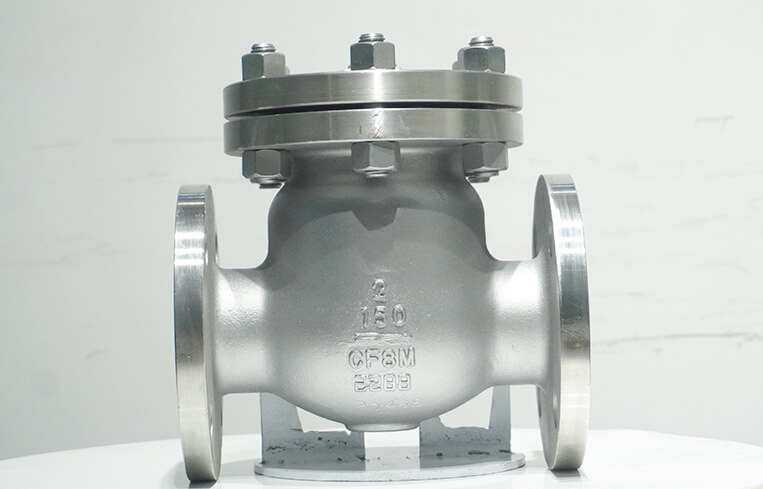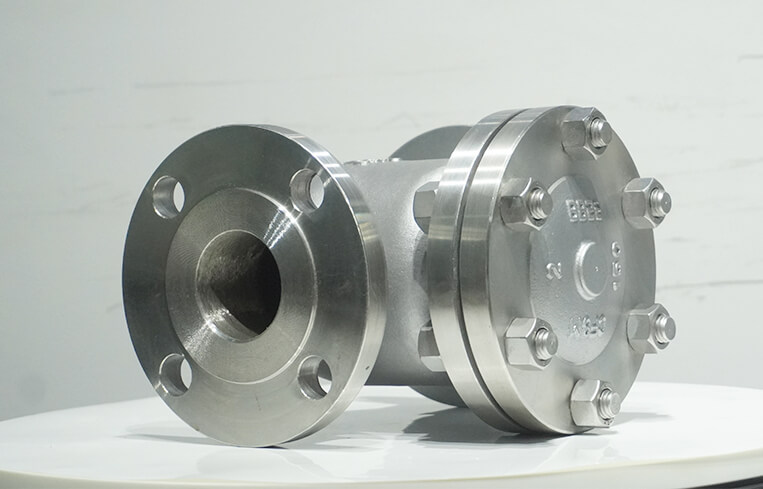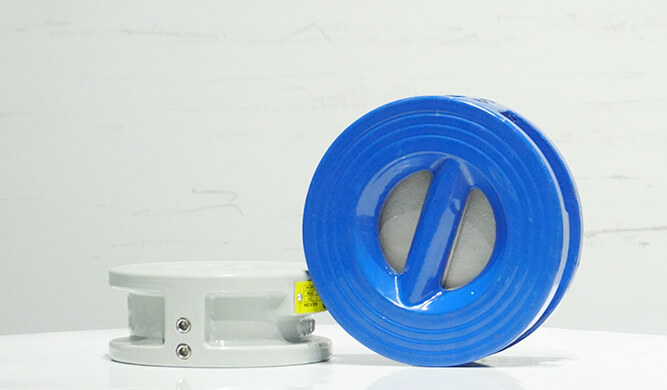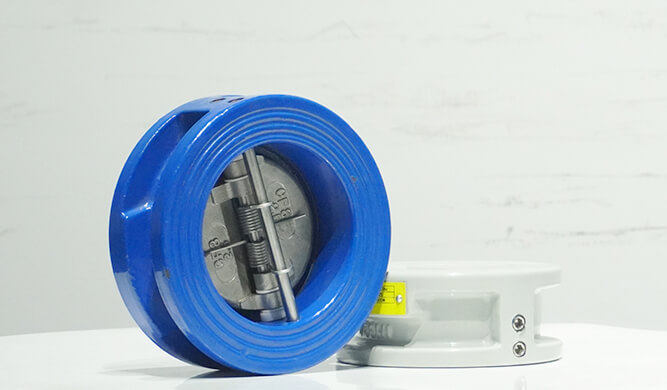Case

Case

Check valve refers to a valve whose opening and closing parts are circular discs and rely on their own weight and medium pressure to act to block the reverse flow of the medium. It belongs to the automatic valve category, also known as check valve, one-way valve, return valve or isolation valve.
The function of this type of valve is to allow the medium to flow in one direction only and prevent the flow in the opposite direction. Usually this kind of valve works automatically. Under the pressure of fluid flowing in one direction, the valve disc opens; when the fluid flows in the opposite direction, the fluid pressure and the self-weight of the valve disc act on the valve seat, thus cutting off the flow.
The valve disc of the swing check valve is disc-shaped and rotates around the rotating axis of the valve seat channel. Because the inner channel of the valve is streamlined, the flow resistance is smaller than that of the lift check valve. It is suitable for low flow rates and infrequent changes in flow. It is suitable for large diameter occasions, but it is not suitable for pulsating flow, and its sealing performance is not as good as that of the lifting type.
Swing check valves are divided into three types: single-disc type, double-disc type and multi-disc type. These three forms are mainly divided according to the valve diameter. The purpose is to prevent the medium from stopping the flow or backflow and weakening the hydraulic impact.


A check valve whose valve disc slides along the vertical centerline of the valve body. The lift check valve can only be installed on horizontal pipelines. The valve disc can be made of round balls on high-pressure small-diameter check valves. The valve body shape of the lift check valve is the same as that of the stop valve (can be used universally with the stop valve), so its fluid resistance coefficient is larger. Its structure is similar to that of a globe valve, and its valve body and disc are the same as those of a globe valve.
The upper part of the valve disc and the lower part of the valve cover are processed with guide sleeves. The valve disc guide sleeve can be freely raised and lowered in the valve guide sleeve. When the medium flows forward, the valve disc opens by the thrust of the medium. When the medium stops flowing, the valve disc opens by itself. It falls vertically on the valve seat to prevent the backflow of the medium.
The direction of the medium inlet and outlet channels of the straight-through lift check valve is perpendicular to the direction of the valve seat channel; the direction of the medium inlet and outlet channels of the vertical lift check valve is the same as the direction of the valve seat channel, and its flow resistance is smaller than that of the straight-through type.
A check valve in which the disc rotates around a pin in the valve seat. The disc check valve has a simple structure and can only be installed on horizontal pipelines, so its sealing performance is poor.


A valve whose disc slides along the centerline of the valve body. The pipeline check valve is a new type of valve. It is small in size, light in weight and has good processing technology. It is one of the development directions of check valves. However, the fluid resistance coefficient is slightly larger than that of the swing check valve.
This kind of valve is used as a boiler feed water and steam cut-off valve. It has the comprehensive functions of a lift check valve and a stop valve or angle valve.
In addition, there are some check valves that are not suitable for installation at the pump outlet, such as foot valves, spring-type, Y-type, etc.
1.Do not let the check valve bear weight in the pipeline system. Large check valves should be supported independently so that they are not affected by the pressure generated by the pipeline system.
2.When installing, please note that the direction of medium flow should be consistent with the direction of the arrow marked on the valve body.
3.The lifting vertical flap check valve should be installed on the vertical pipeline.
4.Lift-type horizontal flap check valve should be installed on horizontal pipelines.
Butterfly double-disc check valve is suitable for water supply pipe networks in high-rise buildings, pipe networks with certain chemically corrosive media, pipe networks with limited installation space, and sewage pipe networks.
The lift-type silent check valve is suitable for pipe networks with high quality requirements for water supply and drainage projects; pipe networks with relatively high pressure requirements (PN2.5Mpa); it can be installed at the outlet of the pump and is an economical and practical waterproof hammer check valve.
The lift type silencer check valve is suitable for water supply and drainage systems and high-rise building pipe networks. It can be installed at the outlet of the pump. With a slight structural modification, it can be used as a water suction bottom valve, but it is not suitable for sewage pipe networks.
Horizontal check valve is suitable for submersible, drainage and sewage pumps, especially for sewage and sludge systems.
Swing rubber check valve is suitable for domestic water pipe networks; but it is not suitable for sewage with a lot of sediments.
Swing single-disc check valve is suitable for water supply systems, petroleum, chemical industry, metallurgy and other industrial sectors, and is most suitable for places with limited installation space.
1.In order to prevent the backflow of the medium, check valves should be installed on equipment, devices and pipelines;
2.Check valves are generally suitable for clean media and are not suitable for media containing solid particles and high viscosity;
3.Generally, lift check valves should be used on horizontal pipelines with a nominal diameter of 50mm;
4.The straight-through lift check valve can only be installed on horizontal pipelines;
5.For the water pump inlet pipeline, a bottom valve should be used. The bottom valve is generally only installed on the vertical pipe at the pump inlet, and the medium flows from bottom to top;
6.The lifting type has better sealing and greater fluid resistance than the swing type. The horizontal type should be installed on horizontal pipes, and the vertical type should be installed on vertical pipes;
7.The installation position of the swing check valve is not restricted. It can be installed on horizontal, vertical or inclined pipelines. If installed on a vertical pipeline, the medium flow direction must be from bottom to top;
8.The swing check valve should not be made into a small-diameter valve. It can be made into a very high working pressure. The nominal pressure can reach 42MPa, and the nominal diameter can also be very large, up to 2000mm or more. Depending on the materials of the shell and seals, it can be applied to any working medium and any working temperature range. The medium is water, steam, gas, corrosive medium, oil, medicine, etc. The working temperature range of the medium is between -196--800℃;
9.The swing check valve is suitable for low pressure and large diameter, and the installation location is limited;
10.The installation position of butterfly check valve is not restricted and can be installed on horizontal pipelines, vertical or inclined pipelines;
11.Ball check valve is suitable for medium and low pressure pipelines and can be made into large diameter;
The reason why the valve disc is broken is that the pressure of the medium before and after the check valve is close to balance and "see-sawing" with each other.
The valve disc often slaps against the valve seat. Valve made of certain brittle materials (such as cast iron, brass, etc.) The flap was shattered.
The preventive method is to use a check valve with a flexible material.
The reasons for medium backflow are:
①The sealing surface is damaged;
②Inclusion of impurities.
Repairing the sealing surface and cleaning impurities can prevent backflow.